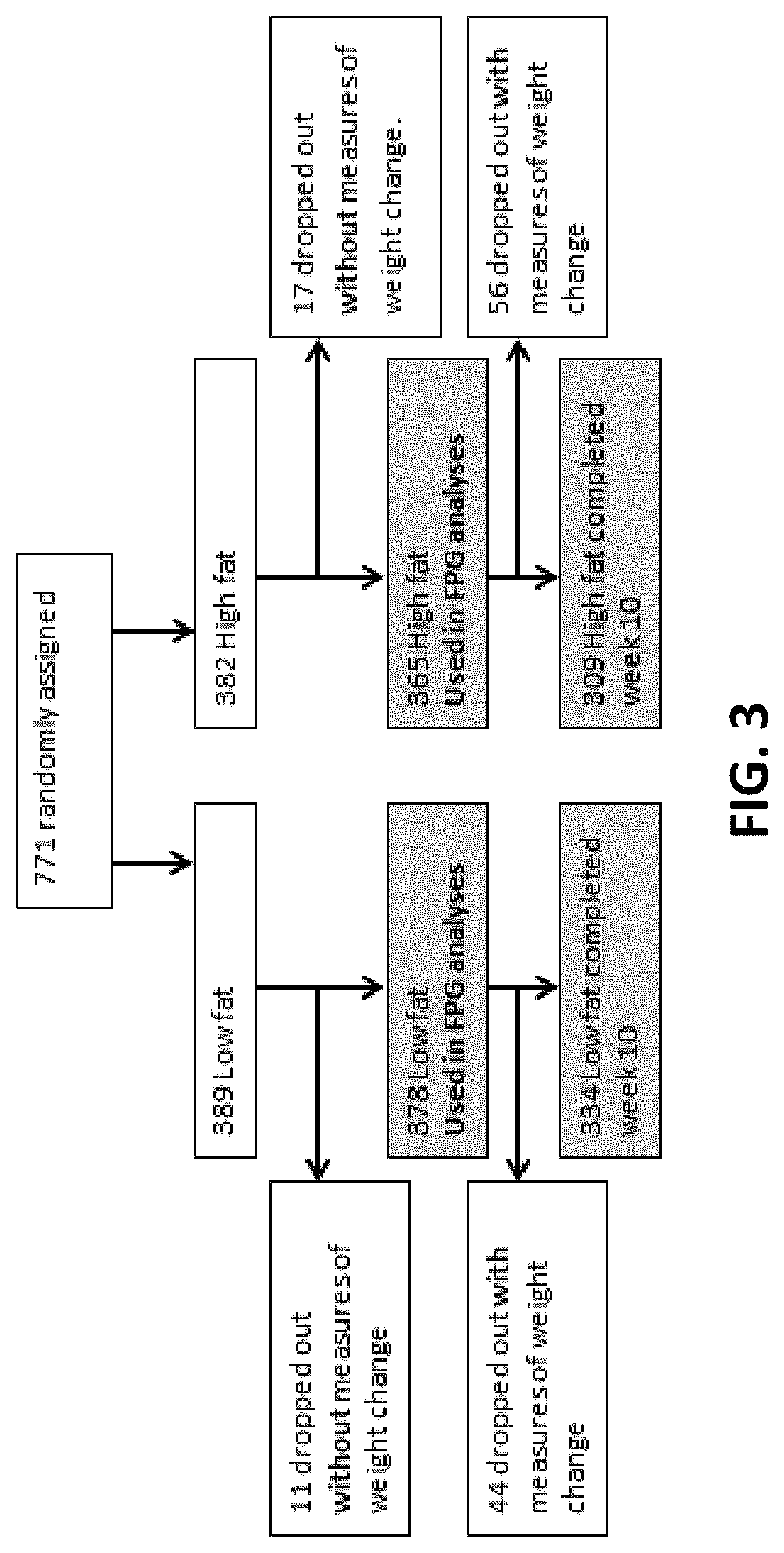Methods of inducing weight loss
a weight loss and method technology, applied in the field of inducing weight loss, can solve the problems of inability to measure insulin 30 min after a standardized oggt, inability to adapt to the changes in energy expenditure, and inability to account for the variability of metabolic efficiency and adaptive reductions in energy expenditure, so as to improve the predictive power of the method, improve the effect of dietary weight loss success and fat loss
- Summary
- Abstract
- Description
- Claims
- Application Information
AI Technical Summary
Benefits of technology
Problems solved by technology
Method used
Image
Examples
example 1
ment Fasting Plasma Glucose and Insulin Modify Dietary Weight Loss Success: Results from Three Randomized Clinical Trials
[0329]The purpose of this study was to investigate fasting plasma glucose (FPG) and FI as prognostic markers for weight loss and weight loss maintenance when allocated to pairs of diets varying in macronutrient content, glycaemic load and fibre / wholegrain from three randomized clinical trials. This was done in order to find the best weight loss and weight loss maintenance diet for patients with different glycaemic and insulinemic status.
Subjects and Methods
[0330]We reanalyzed three randomized clinical trials—the Diet, Obesity, and Genes (DiOGenes) conducted in eight European countries (9, 10), the OPUS Supermarket intervention (SHOPUS) conducted in Denmark (11), and the Nutrient-gene interactions in human obesity (NUGENOB) conducted in seven European countries (12). Participant flow diagram of the three studies can be found in supplementary material (FIGS. 1-3). T...
example 2
w GL Diet and High GI / High GL Diet
[0372]The Diogenes database was used with the aim of finding an accurate measurement for classification of individuals as insulin resistant / sensitive.
[0373]The prediabetic obese subjects (FPG 100-125 mg / dl) were slightly older, consisted of relatively more males and had a slightly higher BMI compared to the non-diabetic obese subjects (FPG<100 mg / dl) (P≤0.016) (Table 1).
[0374]
TABLE 7Baseline characteristics of the overweight / obese study population stratified by glycemic statusNon-diabetic Prediabetic subjectssubjects(n = 617)(n = 118)P-valueAge41.1 6.243.3 6.20.001Gender (male / 33% / 67%45% / 55%0.016female)Height (cm)170.4 ± 9.1 169.6 ± 10.30.44Body weight (kg) 99.5 ± 16.9102.6 ± 19.50.069Fat-free mass (kg)58.5 (50.9; 70.6)156.8 (50.0; 68.2)20.163Fat-mass (kg)38.4 (32.1; 46.5)139.7 (31.5; 49.4)20.903BMI34.2 ± 4.735.5 ± 4.90.007Data are presented as mean ± standard deviation, median (interquartile range) or proportions.Differences were tested using a two...
example 3
w GL Diet and High GI / High GL Diet, More Patients
[0380]This analysis was performed on the Diogenes database as in Example 1.
Analysis Based on FPG
[0381]Subjects were classified as high FPG / low FPG (same as high / low FPG) before they started the low calorie diet (LCD). Weight loss during the 8-week low calorie diet was lower among prediabetics compared to non-diabetic obese subjects [−0.76 (−1.20; −0.31) kg; P=0.001] and fat loss tended to be lower [−0.98 (−2.00; 0.03) P=0.058]. FIG. 8 presents absolute weight loss during the LCD-period among these two groups.
[0382]During the subsequent 6 month ad libitum diet phase the high CHO-high GI diet resulted in a greater weight regain [2.76 (0.55; 4.98) kg; (p=0.014)] among prediabetics compared to the normoglycemic subjects, whereas the weight regain was lower among prediabetics compared to normoglycemic subjects (−1.62 (−3.07; −0.18)] kg (p=0.027) when allocated to the low CHO / low GI diet. No difference in weight regain was observed among th...
PUM
 Login to View More
Login to View More Abstract
Description
Claims
Application Information
 Login to View More
Login to View More - R&D
- Intellectual Property
- Life Sciences
- Materials
- Tech Scout
- Unparalleled Data Quality
- Higher Quality Content
- 60% Fewer Hallucinations
Browse by: Latest US Patents, China's latest patents, Technical Efficacy Thesaurus, Application Domain, Technology Topic, Popular Technical Reports.
© 2025 PatSnap. All rights reserved.Legal|Privacy policy|Modern Slavery Act Transparency Statement|Sitemap|About US| Contact US: help@patsnap.com



